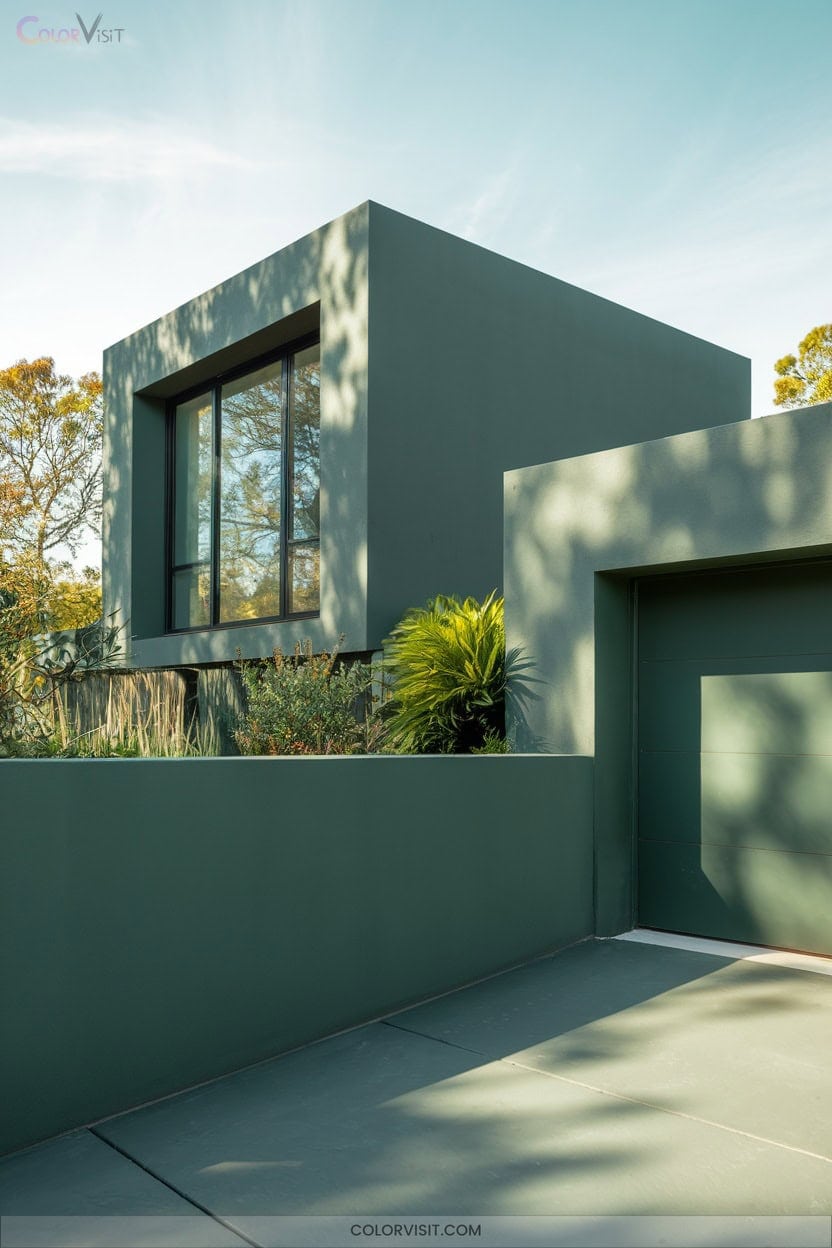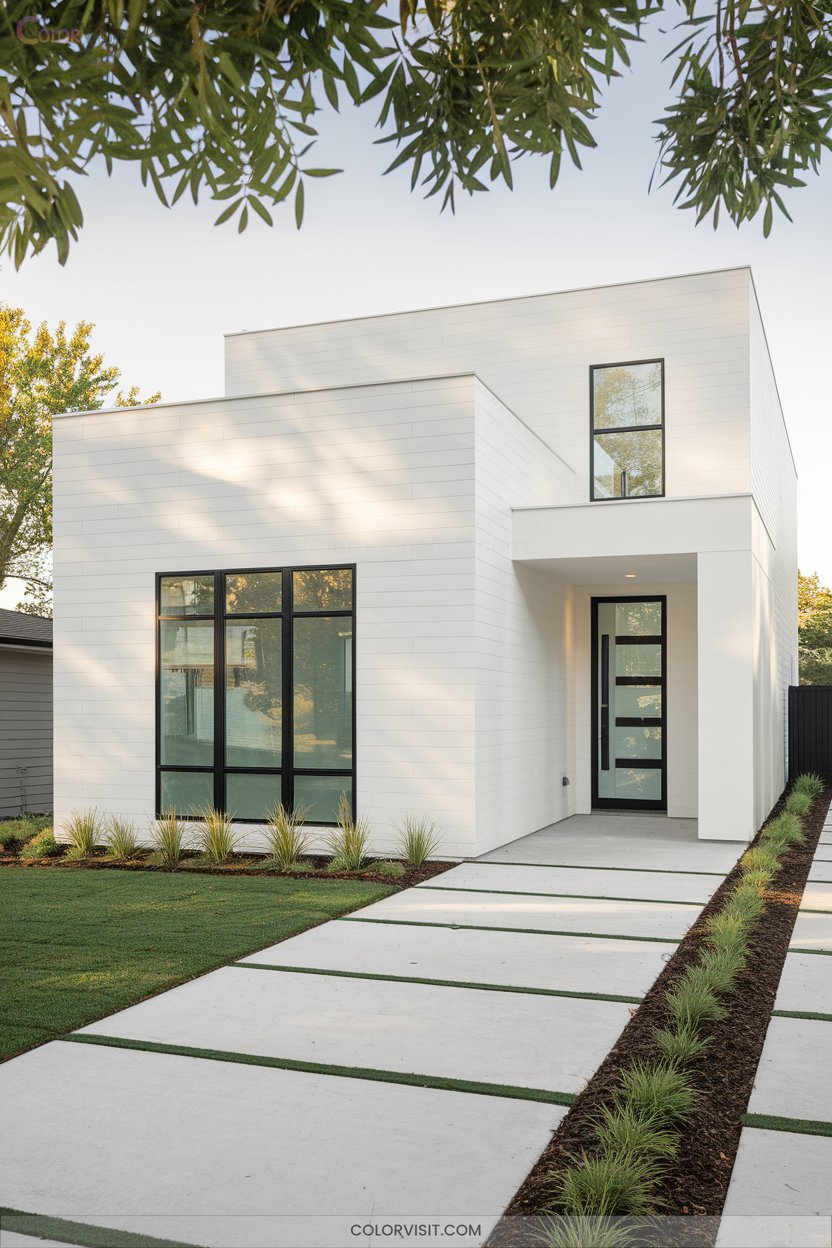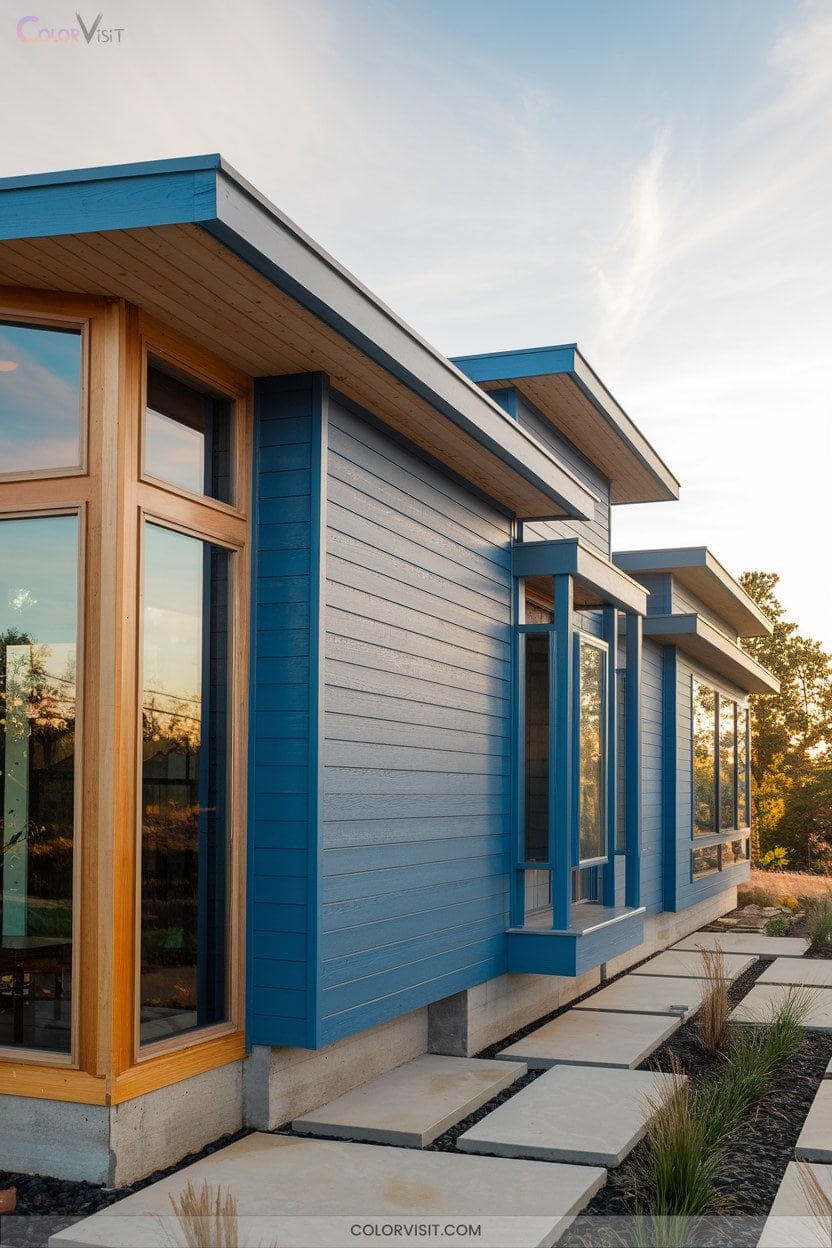18 Modern Exterior House Color Ideas for 2025
If you’re searching for modern exterior house color ideas for 2025, prioritize earthy sage green for a serene, sustainable look or sophisticated blues like Quietude for biophilic design. Embrace soft warm oranges and vibrant yellows as strategic accents, while linen beige paired with crisp white trim guarantees timeless appeal.
Forest greens, bold trims, and materials that coordinate with your local landscape set new architectural standards. Discover how these palettes elevate curb appeal and property value by exploring further.
1. Earthy Sage Green for a Calming Natural Aesthetic
Earthy sage green offers a sophisticated, nature-inspired palette that’s redefining modern exterior design in 2025.
Earthy sage green is setting a new standard for sophisticated, nature-inspired exteriors in 2025.
You’ll find its calming ambiance aligns seamlessly with sustainability trends and a desire for tranquil living environments.
As a ‘new neutral,’ sage green adapts to traditional, coastal, cottage, and blended architecture.
Explore dynamic shades like Saybrook Sage, Studio Green, or Evergreen Fog to achieve nuanced undertones and visual depth.
Pair it with crisp white trim, natural wood, or stone accents for a harmonious, contemporary exterior.
This forward-thinking hue enhances architectural character, embodying both versatility and modernity for exteriors that merge innovation with nature.
2. Soft Warm Orange for Inviting Modern Facades
A soft warm orange instantly elevates modern facades by infusing exteriors with a welcoming, contemporary energy rooted in current color trends.
This muted hue—think Sherwin-Williams’ Nomadic Desert or Behr’s Oxide—delivers warmth without overwhelming architectural lines.
You’ll find the shade’s versatility remarkable; it harmonizes with both light and dark palettes, enhancing stone or wood textures.
Use soft orange strategically on doors, shutters, or gables to create a striking accent.
As 2025 trends emphasize nature-inspired, balanced color schemes, this tone supports design creativity while maintaining year-round appeal.
Pair it with neutrals for a refined, innovative, and inviting exterior aesthetic.
3. Forest Green Inspired by Lush Landscapes
While soft warm orange adds a welcoming vibrancy, forest green offers a sophisticated, nature-driven alternative that’s surging in modern exterior palettes.
If you’re seeking to evoke lush landscapes, opt for deep hues like Benjamin Moore’s Black Forest Green or Sherwin-Williams’ Olympic Range.
These complex, earthy greens create dramatic curb appeal, especially when contrasted with light porch steps or cream details.
Deep, earthy greens deliver striking curb appeal when paired with airy porch steps or subtle cream accents.
Forest green’s architectural versatility makes it ideal for both modern and rustic designs, particularly when paired with wood or brick bases.
Integrate wood accents or highlight features like doors for a bold, grounded aesthetic that seamlessly complements natural surroundings.
4. Linen Beige Paired With Crisp White Trim
When you choose linen beige for your home’s exterior, you’re embracing a versatile neutral that delivers both warmth and architectural sophistication.
This hue’s subtle peachy undertones—think Sherwin-Williams Natural Linen—set a timeless foundation for innovative, modern design.
Crisp white trim creates a high-contrast outline, sharpening your home’s silhouette and amplifying curb appeal.
For 2025, you’ll see linen beige leading in nature-inspired trends and adaptable palettes.
- Pair linen beige siding with white gutters, soffits, and window frames for cohesive visual unity.
- Incorporate dark gray roofing for balanced contrast.
- Use bold accent colors—plum or deep blue—for contemporary flair.
5. Snowbound” Bright White for Timeless Curb Appeal
Embracing modern exterior palettes means exploring whites that offer more than just brightness—Sherwin-Williams Snowbound stands out for its nuanced warmth and versatility.
With a light reflectance value of 83, Snowbound delivers a luminous, reflective surface, yet its subtle taupe and pink undertones prevent a sterile effect.
Utilize it for whole-house facades or crisp trim details to achieve timeless curb appeal that’s both inviting and modern.
Its soft warmth pairs seamlessly with grays, muted blues, and spiced accents, aligning with 2025’s trend toward refined, radiant exteriors.
Avoid green or creamy-yellow pairings for ideal harmony and a truly innovative statement.
6. Muted Blue-Gray “Quietude” for Subtle Sophistication
Serenity meets sophistication with Sherwin-Williams Quietude, a blue-green hue that’s rapidly gaining traction in modern exterior design.
Sherwin-Williams Quietude blends serene blue-green tones with modern sophistication for a fresh, on-trend exterior look.
This medium-light shade, with a Light Reflectance Value (LRV) of 48, delivers a muted yet impactful presence—making it ideal for accent features like front doors or architectural highlights.
Its cool undertones, grounded in green and gray, provide a calming effect that resonates with current biophilic design trends.
For innovative curb appeal, consider these strategies:
- Pair Quietude with SW Pearly White trim for contrast.
- Use peel-and-stick samples to assess real-world lighting.
- Consult digital visualizer tools for precise planning.
7. Vibrant “Convivial Yellow” for Energetic Charm
Radiance defines Sherwin-Williams Convivial Yellow (SW 6393), a vibrant yellow with warm undertones engineered to inject energy and optimism into modern exteriors.
Embrace its dynamic presence by highlighting doors and shutters, creating a bold focal point that aligns with 2025’s nature-inspired, expressive palettes.
Pair it with crisp whites, natural woods, or even contrasting blue hues for a sophisticated, balanced look.
Convivial Yellow’s versatility bridges modern and classic architecture, ensuring year-round warmth and visual intrigue.
As color experts recommend, this hue fosters creativity, community engagement, and a positive emotional impact, making it essential for innovative, forward-thinking home exteriors.
8. Warm Reddish-Brown “Spiced Cider” for Cozy Exteriors
While bold yellows like Convivial Yellow inject energetic vibrancy, many modern homeowners are gravitating toward the warmth and depth of Spiced Cider (SW 7702) for exterior palettes in 2025.
Modern exteriors in 2025 embrace the inviting warmth and earthy depth of Spiced Cider over vibrant yellows.
This rich, reddish-brown hue (#B0785C) offers technical versatility across architectural styles, anchoring facades with earthy sophistication.
Its warm undertones evoke autumnal coziness and foster a harmonious connection with natural landscapes.
For innovative curb appeal, leverage Spiced Cider’s dynamic role:
- Pair with neutral trims like Snowbound for refined contrast.
- Accent doors or shutters for bold, inviting focal points.
- Integrate with wood or stone for organic texture.
9. Southwestern-Inspired “Nomadic Desert” Tan
A quintessential choice for modern exteriors, “Nomadic Desert” tan offers an adaptable, beige-based hue grounded in the warmth of sunbaked landscapes.
You’ll find its warm undertones and balanced chromatic depth make it highly versatile—ideal for siding, stucco, or brickwork.
This shade responds dynamically to lighting, reading warmer in direct sun and cozier in shadow.
It excels in Southwestern-inspired architecture, harmonizing seamlessly with neutral palettes, earth tones, and nature-driven hues like terracotta.
As highlighted in the HGTV Home by Sherwin-Williams 2025 Color Collection, “Nomadic Desert” delivers timeless elegance while adapting to evolving design trends.
Test samples for best results.
10. Gray Heron Earthy Green-Gray for Modern Homes
Gray Heron stands out as a sophisticated, saturated green-gray that’s gaining traction in modern exterior design.
You’ll appreciate its balanced blend of gray and ivy green undertones, making it a forward-thinking choice for innovative homes.
This color delivers both serenity and architectural interest without overpowering your facade.
Emphasize its versatility by integrating Gray Heron in the following ways:
- Pair with natural wood accents for an organic, harmonious effect.
- Use crisp off-white trim to highlight its subtle depth.
- Apply to sunlit or shaded areas—Gray Heron maintains consistency, adapting seamlessly to varying exterior light conditions.
11. Versatile Flagstone Gray as a Contemporary Neutral
Flagstone gray offers a strategic foundation for contemporary exteriors, delivering a mid-tone gray with nuanced undertones that adapt to multiple architectural styles.
You’ll appreciate its versatility—whether your vision is coastal, farmhouse, or mid-century modern, this shade anchors your facade while balancing bold accents like navy or lemon yellow.
Pair flagstone with crisp whites or charcoal trims for striking definition and curb appeal.
Its weather-resistant formulation guarantees durability and minimal maintenance, aligning with sustainable design priorities.
Integrate with landscaping, natural stone, or wood for seamless aesthetic cohesion.
Flagstone gray’s timeless neutrality elevates resale value and keeps your exterior future-forward.
12. Classic Linen With Sharp White Accents
Classic linen siding, enhanced by sharp white accents, creates a sophisticated exterior palette that’s both timeless and adaptable across architectural styles.
You’ll appreciate how this strong neutral base allows for crisp visual contrast and elevates curb appeal with technical precision.
This versatile neutral foundation delivers striking contrast and elevates your home’s curb appeal with a touch of refined precision.
The interplay of linen and white brings out architectural features and fits seamlessly into current design trends.
Consider these innovative strategies:
- Use sharp white soffits, gutters, and window frames to outline and define your home.
- Incorporate natural materials like wood or stone for textural depth.
- Pair with deep, contrasting roofing to establish visual balance and modern appeal.
13. Warm “Caramelized Pears” With Gray or Brown Roofing
Subtle sophistication defines exteriors finished in “Caramelized Pears,” a nuanced yellow with khaki undertones that bridges nostalgic warmth and modern sensibility.
You’ll find this earthy, understated hue aligns perfectly with 2025’s movement toward sun-soaked, grounded palettes.
Pair it with a gray roof—think charcoal asphalt or sleek slate metal—for a balanced, contemporary contrast that accentuates architectural structure.
Alternatively, opt for chocolate or mocha brown roofing to intensify organic coherence and natural warmth.
Incorporate matte finishes, fiber cement siding, and stone or wood accents to reinforce tactile depth.
These combinations cultivate inviting, innovative curb appeal while staying ahead of exterior color trends.
14. Bold Autumn Red and Red Rock Falls for Statement Homes
A dramatic exterior transformation starts with bold hues like Autumn Red, a rich, smoky shade that instantly commands attention and exudes modern rustic charm.
For 2025, embracing this trend means leveraging technical color pairing and accent strategies for a statement home that’s both innovative and timeless.
Integrate these tactics for maximum impact:
- Use Autumn Red as primary siding, offset with crisp white trim for architectural definition.
- Limit bold reds to doors or shutters, pairing with deep neutrals or natural stone for modern edge.
- Enhance sustainability by selecting low-VOC, UV-resistant finishes to preserve vibrancy and longevity.
15. Sophisticated Blue Hues Like Delft and Rocky River
Versatility defines sophisticated blue hues like Delft and Rocky River, making them a strategic choice for contemporary exterior design.
You’ll find Delft blue evokes classic elegance, reminiscent of fine ceramics, while Rocky River delivers a calming, natural ambiance ideal for homes in scenic settings.
These hues adapt seamlessly to modern, colonial, and mid-century architectural styles, supporting both vintage and progressive aesthetics.
Pairing with crisp white, charcoal, or metallic accents intensifies curb appeal, while integrating earthy tones or gradients introduces depth.
With blue’s global popularity and market value benefits, leveraging these hues positions your home at the forefront of 2025’s exterior trends.
16. Contrasting Trims to Accentuate Architectural Details
While timeless blue hues provide a sophisticated foundation, the strategic use of contrasting trims propels any exterior into a contemporary domain.
By deploying bold, dark trims against light walls, you instantly heighten visual drama and architectural definition.
Material-inspired hues—think brick red or steel gray—complement mixed facades, while monochromatic black-on-gray trims emphasize modern geometric lines.
To innovate further, consider these technical pairings:
- Apply deep, earthy trims with muted walls for warmth and modernity.
- Accent window casings or fascia boards with bold, saturated colors.
- Integrate wood or composite trims with metal for a balanced, textural statement.
17. Coordinated Porch Flooring and Entry Steps
Seamless coordination between porch flooring and entry steps defines a truly modern exterior, setting the stage for elevated curb appeal in 2025.
Match materials—composite decking, stone, brick, or concrete—for cohesive visual alignment and superior durability. Prioritize uniform finishes, such as matte or polished, and synchronize color palettes with trending neutrals like greys or taupes for understated sophistication.
Harmonize porch and step materials and finishes in trending neutrals for a unified, sophisticated exterior that endures.
Maintain pattern orientation and integrate stair nosings to guarantee uninterrupted flow. Select materials with equivalent slip resistance and weather resilience.
Execute meticulous planning for flush joints and precise interfaces. This synergy between porch and steps exemplifies modern design innovation and functional harmony.
18. Blending Exterior Colors With Local Landscape and Materials
Blending exterior colors with your local landscape and materials grounds a modern home in its environment while amplifying architectural character.
For 2025, innovative palettes draw inspiration from natural and built surroundings, seamlessly integrating form and function.
Use these strategies to achieve a cohesive, forward-thinking exterior:
- Reference the landscape: Choose earthy gray, sage green, or sunset-inspired hues to harmonize with foliage, sky, or stone.
- Match local materials: Complement brick, stone, or wood with quietude, delft, or woody green for a unified façade.
- Balance with neutrals: Employ stucco or rocky river tones as a base, enhancing contrast and longevity.
Frequently Asked Questions
Cómo Elegir El Mejor Color Exterior Según El Clima De Mi Región?
Let climate be your color compass—reflect solar glare with luminous neutrals in heat, cocoon warmth with deep pigments in cold, and shield dampness with mid-tone, mildew-resistant paints. Prioritize finishes and palettes that harmonize with local environmental dynamics.
Qué Tipo De Pintura Exterior Es Más Duradera Para Diferentes Climas?
You should choose high-performance, acrylic-based exterior paints with UV protection and advanced waterproofing. Look for antimicrobial, flexible formulations that resist fading, cracking, and mold. Modern coatings with breathable technology guarantee longevity across tropical, coastal, cold, or extreme environments.
Cuánto Influye La Orientación Solar Al Seleccionar El Color De Fachada?
You must prioritize solar orientation when selecting façade color, since sunlight intensity and angle directly impact thermal gain and color perception. Embrace light-reflective hues for sun-exposed façades and consider trendy, darker shades for thermally protected orientations.
Qué Mantenimiento Requieren Los Colores Exteriores Modernos En Casas Nuevas?
Did you know innovative exterior palettes demand proactive care? You’ll need to clean surfaces regularly, inspect for UV or moisture damage, apply high-performance sealers, and schedule annual touch-ups to preserve vibrancy, finish integrity, and the architectural impact of modern hues.
Cómo Afectan Las Regulaciones Locales O De Fraccionamientos a La Elección De Colores?
You must navigate zoning codes and community covenants, which often restrict color palettes to guarantee visual harmony and environmental compliance. These regulations limit creative freedom, but you can leverage sustainable materials and trending, approved hues to innovate within boundaries.
Conclusion
As you consider your home’s next exterior palette, remember that 68% of homeowners say color choice directly impacts curb appeal and resale value. By embracing trend-forward hues like sage green, sophisticated blues, or bold contrasting trims, you’re not just elevating aesthetics—you’re making a strategic investment in your property.
Don’t hesitate to blend modern color science with your local landscape to create a home exterior that’s both contemporary and uniquely yours for 2025.



















